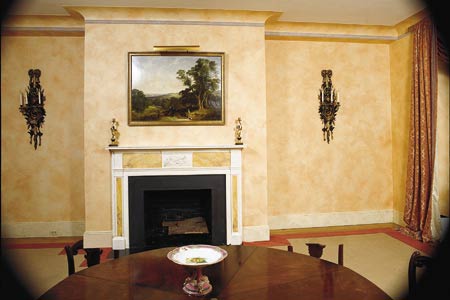Decorate with a two-tone patina
To create the effect of patinaed plaster you need to apply two different colours of glaze over a base coat of paint, then blot with cheesecloth. The technique works well with colours from the same family, but can also work with unrelated colours.
One foolproof method is to pick a finish colour from a colour swatch, then go one shade lighter for the base and use the finish colour and a shade one notch darker for the two tinted glazes. But remember: Always test a scheme on posterboard before committing to it on the wall.
The secret to decorative painting is scumble glaze, a transparent coating that's tinted and applied over a painted wall. Scumble glaze is sold untinted, so to get the colour you want you'll need to add paint. To get the colour right, fill a small bucket with glaze and add paint little by little. Make sure your base paint and all glazes are thoroughly mixed and that you try them out together on a test piece of primed drywall before you begin.
YOU WILL NEED:
Prominent Paint base colour, final tint colour and darker tint colour
Scumble glaze
Stipple brush oblong, with flat bristles
Glazing Brush
Glazing brush round with rounded bristles
Fine Brush
Fine brush thick and rectangular, with squared-off bristles
Cheesecloth
HERE'S HOW:
1. Prepare the wall Paint the wall in the base colour. Allow to dry. When using scumble glaze it's necessary to work in manageable 1-metre sections so the wall doesn't dry as you work. Using a piece of cheesecloth, spread on a coat of clear glaze to help keep the surface workable longer.
2. Apply the first colour Apply the first tinted (medium colour) glaze to the wall with a round glazing brush. Use short, quick wrist movements to make a random, loose X pattern while keeping your elbow steady.
3. Add the second colour Fill in blank spots on the wall with the second glaze colour, using the same wrist flick to make more X's.
4. Blend the brush marks
Tap a dry stipple brush against the wall, starting at one side and moving slowly and methodically across the work area.
Tap from the wrist, at the same time twisting the brush like a dial by raising and lowering your elbow.
5. Blot excess glaze
Crumple a section of cheesecloth into a loose ball. Blot the wall, using the same motion as for stippling.
When the cloth surface is saturated, shake it out and recrumple it. When the whole cloth is soaked, replace it with a new piece.
6. Smooth out the colour
Take a dry fine brush and stroke it across the glaze to soften any sharp marks. Make broad horizontal figure eights with the brush to feather the colours into one another.


